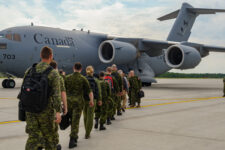
Washington: Despite drastic changes made by the Army and the Marine Corps to the Joint Light Tactical Vehicle program, defense companies are still struggling to get costs under control, according to an industry official.
Kathryn Hasse, JLTV program manager for Lockheed Martin, said costs for the new combat truck continue to be the program’s “most challenging” aspect.
To that end, company officials plan to sit down with Pentagon officials this week to discuss how Lockheed is working to get its proposal under the cost cap set by the services, she said during a briefing today at the U.S. Army Association’s annual symposium.
Other competitors on the JLTV program, including AM General, Navistar, BAE Systems and General Dynamics, are also scheduled to meet with military officials to discuss their JLTV plans.
Earlier this month, the Army issued a revised proposal request for the vehicle, which included a drastically shortened development timeline and a cost cap of just over $200,000 per vehicle.
This cap is roughly $150,000 less than what Army acquisition officials had originally planned to spend. To get to that new price, the Army traded off certain communications and force protection measures for the new vehicles.
The revised proposals request was drafted weeks after the Senate appropriators opted to kill the vehicle, due to excessive cost growth and schedule delays.
Since the Army issued the new JLTV proposal, top service leaders — including Army Chief of Staff Gen. Ray Odierno — have ramped up the rhetoric on the need for the JLTV within the service.
As designed, the truck would fill the gap between the Humvee and the larger Mine Resistant Ambush Protected Vehicle for the Army and Marine Corps.
The changes made to the JLTV requirements will not force a major redesign of the vehicle, according to Hasse. “Technically we are very comfortable” with the changes, she said.
Those changes have also alleviated some of the pressure tied to dropping the total costs of the vehicles, she said, but noted the issue remains the single biggest challenge to the program.
Hasse claimed that soldier safety or ability to do their missions with the JLTV would not be compromised by the trade-offs made by service officials to meet cost goals.
On force protection, Hasse did note that not all of the JLTVs built by Lockheed under the new plan will have enhanced armor protection. That armor would have come stock on each JLTV under the old procurement plan.
The armor, she added, will now be offered as optional “kits” that Army crews can bolt onto the JLTV, depending on the mission. Hasse said making the enhanced armor an option and not a standard feature was strictly to get the base costs below the Army’s cap.
The Lockheed program chief was adamant that the move did not mean that Army or Marine Corps units riding in a JLTV would have less protection than they would have.
Lockheed also ramped down the command and control system for the vehicle, changing it to a “scalable” approach and letting combat commanders decide how much or how little of the system they want on the truck.
Lithuania, Rheinmetall sign agreement for 155mm ammunition plant
“The establishment of the … ammunition factory in Lithuania will reduce our dependence on long supply chains, which currently pose great challenges in meeting the needs of the armies throughout the European Union and the world,” said Laurynas Kasčiūnas, Lithuania’s Minister of National Defense.


























